Business and professional ethics
VerifiedAdded on 2023/06/11
|10
|2871
|231
AI Summary
Essay 2 discusses additional theory and theory extension on the issue of using animal fur for fashion industry. The theory of environmental ethics is applicable to the issue and it states that animals have rights and privileges. The essay also suggests recommendations to resolve the issue.
Contribute Materials
Your contribution can guide someone’s learning journey. Share your
documents today.
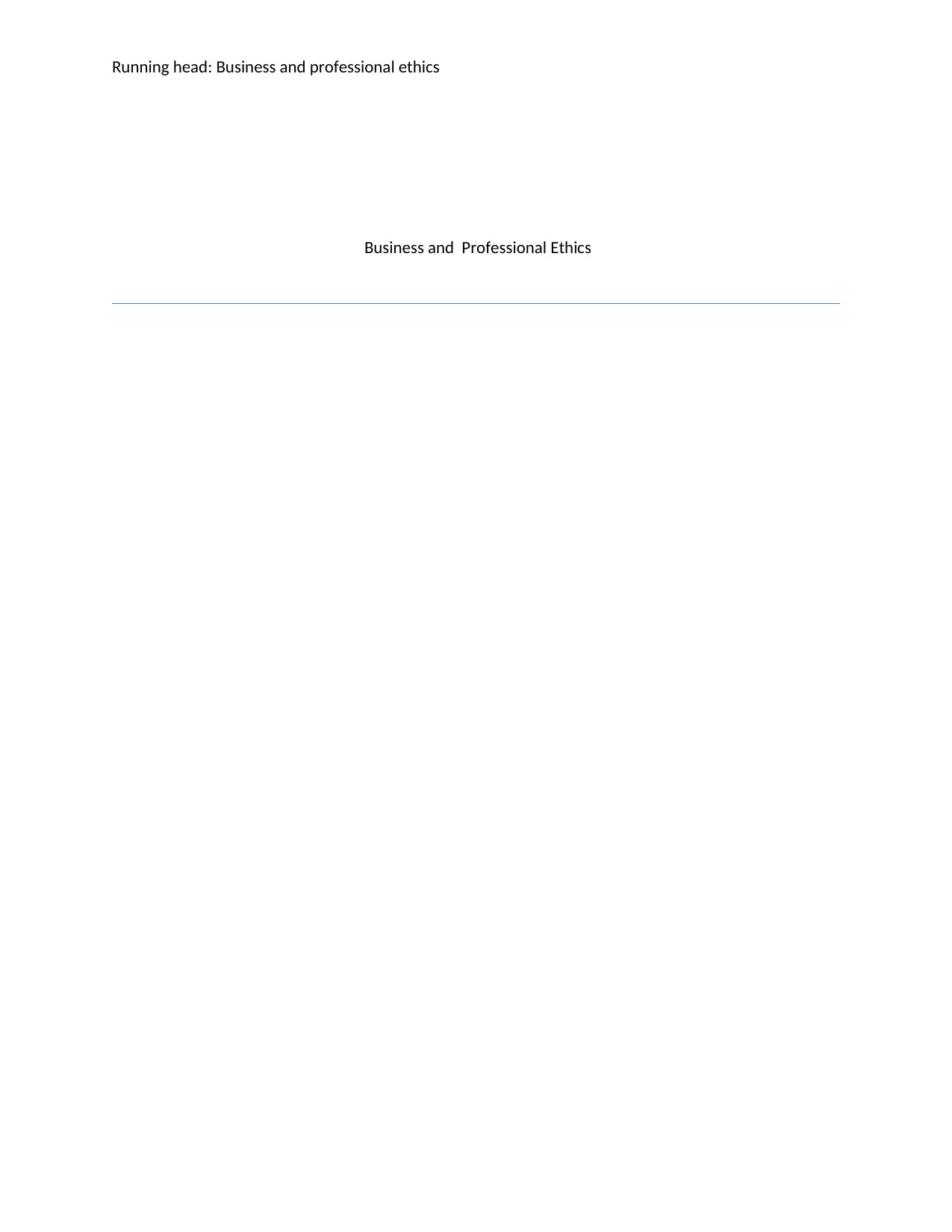
Running head: Business and professional ethics
Business and Professional Ethics
Business and Professional Ethics
Secure Best Marks with AI Grader
Need help grading? Try our AI Grader for instant feedback on your assignments.
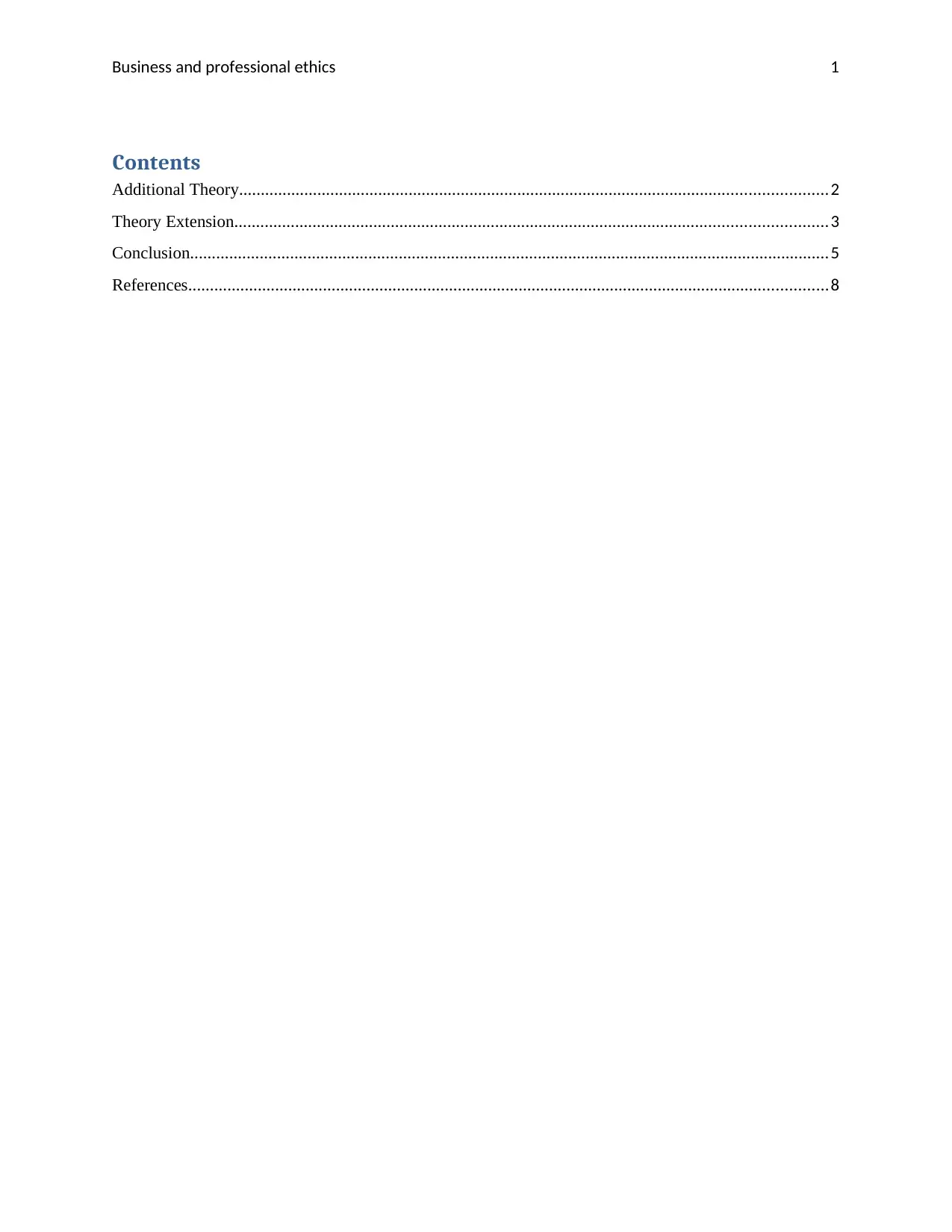
Business and professional ethics 1
Contents
Additional Theory.......................................................................................................................................2
Theory Extension........................................................................................................................................3
Conclusion...................................................................................................................................................5
References...................................................................................................................................................8
Contents
Additional Theory.......................................................................................................................................2
Theory Extension........................................................................................................................................3
Conclusion...................................................................................................................................................5
References...................................................................................................................................................8
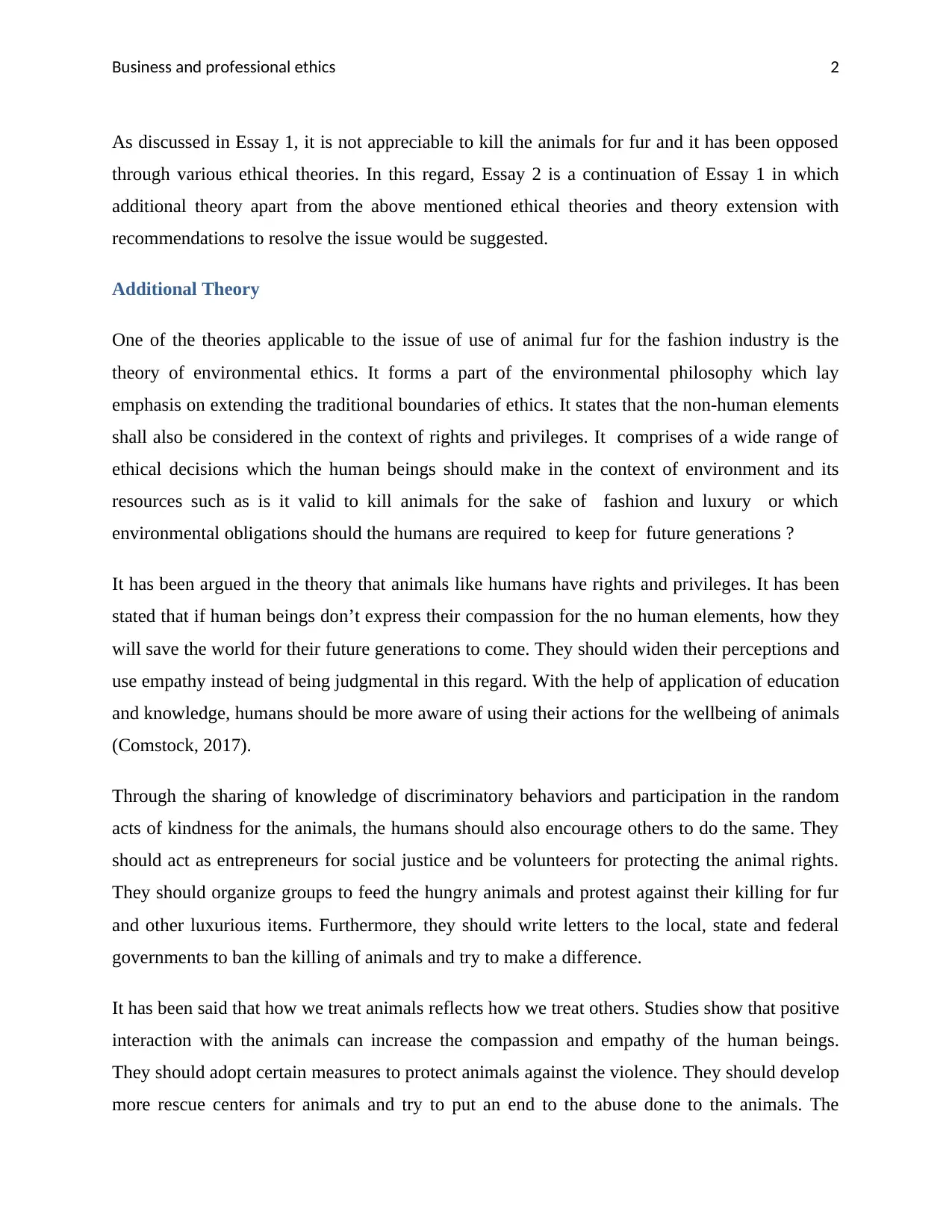
Business and professional ethics 2
As discussed in Essay 1, it is not appreciable to kill the animals for fur and it has been opposed
through various ethical theories. In this regard, Essay 2 is a continuation of Essay 1 in which
additional theory apart from the above mentioned ethical theories and theory extension with
recommendations to resolve the issue would be suggested.
Additional Theory
One of the theories applicable to the issue of use of animal fur for the fashion industry is the
theory of environmental ethics. It forms a part of the environmental philosophy which lay
emphasis on extending the traditional boundaries of ethics. It states that the non-human elements
shall also be considered in the context of rights and privileges. It comprises of a wide range of
ethical decisions which the human beings should make in the context of environment and its
resources such as is it valid to kill animals for the sake of fashion and luxury or which
environmental obligations should the humans are required to keep for future generations ?
It has been argued in the theory that animals like humans have rights and privileges. It has been
stated that if human beings don’t express their compassion for the no human elements, how they
will save the world for their future generations to come. They should widen their perceptions and
use empathy instead of being judgmental in this regard. With the help of application of education
and knowledge, humans should be more aware of using their actions for the wellbeing of animals
(Comstock, 2017).
Through the sharing of knowledge of discriminatory behaviors and participation in the random
acts of kindness for the animals, the humans should also encourage others to do the same. They
should act as entrepreneurs for social justice and be volunteers for protecting the animal rights.
They should organize groups to feed the hungry animals and protest against their killing for fur
and other luxurious items. Furthermore, they should write letters to the local, state and federal
governments to ban the killing of animals and try to make a difference.
It has been said that how we treat animals reflects how we treat others. Studies show that positive
interaction with the animals can increase the compassion and empathy of the human beings.
They should adopt certain measures to protect animals against the violence. They should develop
more rescue centers for animals and try to put an end to the abuse done to the animals. The
As discussed in Essay 1, it is not appreciable to kill the animals for fur and it has been opposed
through various ethical theories. In this regard, Essay 2 is a continuation of Essay 1 in which
additional theory apart from the above mentioned ethical theories and theory extension with
recommendations to resolve the issue would be suggested.
Additional Theory
One of the theories applicable to the issue of use of animal fur for the fashion industry is the
theory of environmental ethics. It forms a part of the environmental philosophy which lay
emphasis on extending the traditional boundaries of ethics. It states that the non-human elements
shall also be considered in the context of rights and privileges. It comprises of a wide range of
ethical decisions which the human beings should make in the context of environment and its
resources such as is it valid to kill animals for the sake of fashion and luxury or which
environmental obligations should the humans are required to keep for future generations ?
It has been argued in the theory that animals like humans have rights and privileges. It has been
stated that if human beings don’t express their compassion for the no human elements, how they
will save the world for their future generations to come. They should widen their perceptions and
use empathy instead of being judgmental in this regard. With the help of application of education
and knowledge, humans should be more aware of using their actions for the wellbeing of animals
(Comstock, 2017).
Through the sharing of knowledge of discriminatory behaviors and participation in the random
acts of kindness for the animals, the humans should also encourage others to do the same. They
should act as entrepreneurs for social justice and be volunteers for protecting the animal rights.
They should organize groups to feed the hungry animals and protest against their killing for fur
and other luxurious items. Furthermore, they should write letters to the local, state and federal
governments to ban the killing of animals and try to make a difference.
It has been said that how we treat animals reflects how we treat others. Studies show that positive
interaction with the animals can increase the compassion and empathy of the human beings.
They should adopt certain measures to protect animals against the violence. They should develop
more rescue centers for animals and try to put an end to the abuse done to the animals. The
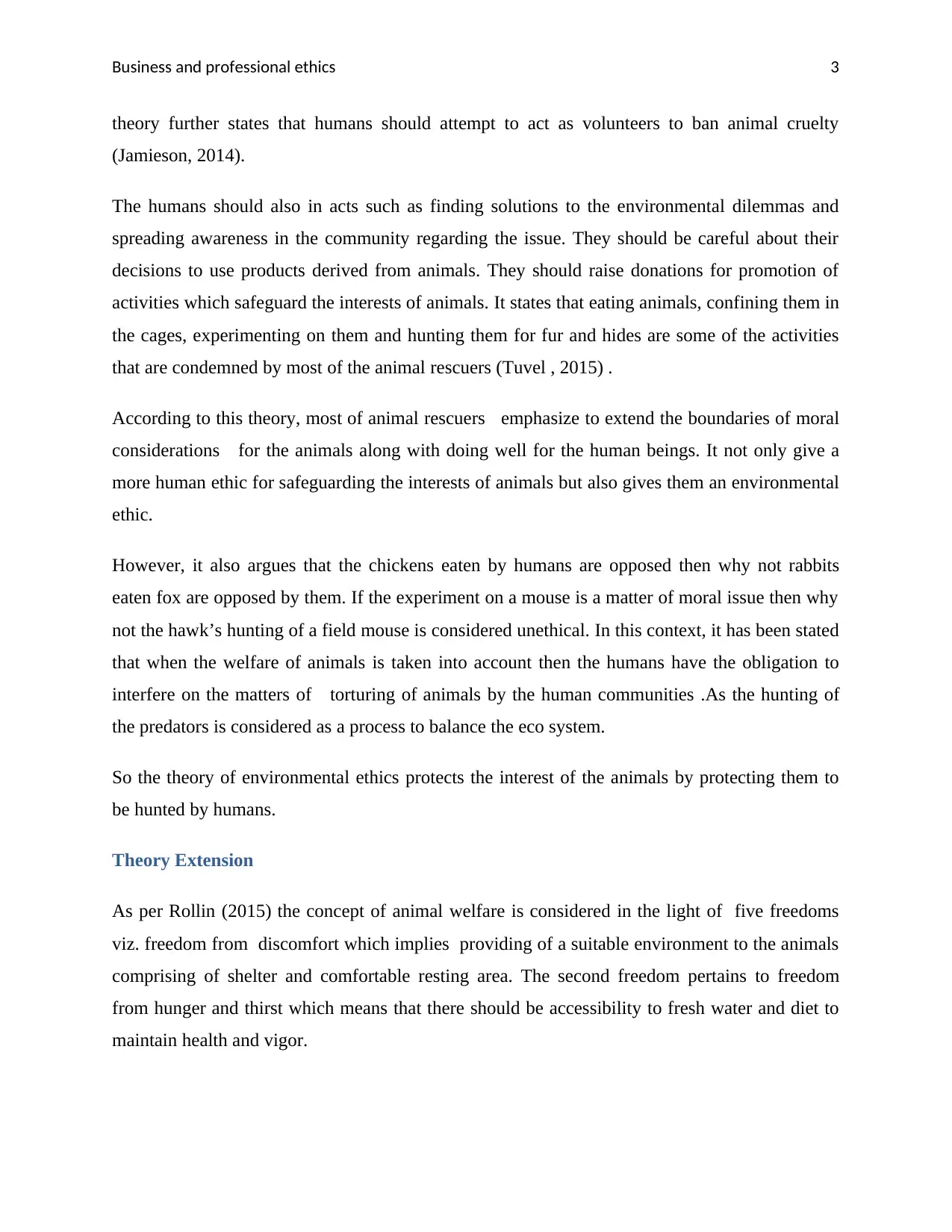
Business and professional ethics 3
theory further states that humans should attempt to act as volunteers to ban animal cruelty
(Jamieson, 2014).
The humans should also in acts such as finding solutions to the environmental dilemmas and
spreading awareness in the community regarding the issue. They should be careful about their
decisions to use products derived from animals. They should raise donations for promotion of
activities which safeguard the interests of animals. It states that eating animals, confining them in
the cages, experimenting on them and hunting them for fur and hides are some of the activities
that are condemned by most of the animal rescuers (Tuvel , 2015) .
According to this theory, most of animal rescuers emphasize to extend the boundaries of moral
considerations for the animals along with doing well for the human beings. It not only give a
more human ethic for safeguarding the interests of animals but also gives them an environmental
ethic.
However, it also argues that the chickens eaten by humans are opposed then why not rabbits
eaten fox are opposed by them. If the experiment on a mouse is a matter of moral issue then why
not the hawk’s hunting of a field mouse is considered unethical. In this context, it has been stated
that when the welfare of animals is taken into account then the humans have the obligation to
interfere on the matters of torturing of animals by the human communities .As the hunting of
the predators is considered as a process to balance the eco system.
So the theory of environmental ethics protects the interest of the animals by protecting them to
be hunted by humans.
Theory Extension
As per Rollin (2015) the concept of animal welfare is considered in the light of five freedoms
viz. freedom from discomfort which implies providing of a suitable environment to the animals
comprising of shelter and comfortable resting area. The second freedom pertains to freedom
from hunger and thirst which means that there should be accessibility to fresh water and diet to
maintain health and vigor.
theory further states that humans should attempt to act as volunteers to ban animal cruelty
(Jamieson, 2014).
The humans should also in acts such as finding solutions to the environmental dilemmas and
spreading awareness in the community regarding the issue. They should be careful about their
decisions to use products derived from animals. They should raise donations for promotion of
activities which safeguard the interests of animals. It states that eating animals, confining them in
the cages, experimenting on them and hunting them for fur and hides are some of the activities
that are condemned by most of the animal rescuers (Tuvel , 2015) .
According to this theory, most of animal rescuers emphasize to extend the boundaries of moral
considerations for the animals along with doing well for the human beings. It not only give a
more human ethic for safeguarding the interests of animals but also gives them an environmental
ethic.
However, it also argues that the chickens eaten by humans are opposed then why not rabbits
eaten fox are opposed by them. If the experiment on a mouse is a matter of moral issue then why
not the hawk’s hunting of a field mouse is considered unethical. In this context, it has been stated
that when the welfare of animals is taken into account then the humans have the obligation to
interfere on the matters of torturing of animals by the human communities .As the hunting of
the predators is considered as a process to balance the eco system.
So the theory of environmental ethics protects the interest of the animals by protecting them to
be hunted by humans.
Theory Extension
As per Rollin (2015) the concept of animal welfare is considered in the light of five freedoms
viz. freedom from discomfort which implies providing of a suitable environment to the animals
comprising of shelter and comfortable resting area. The second freedom pertains to freedom
from hunger and thirst which means that there should be accessibility to fresh water and diet to
maintain health and vigor.
Secure Best Marks with AI Grader
Need help grading? Try our AI Grader for instant feedback on your assignments.
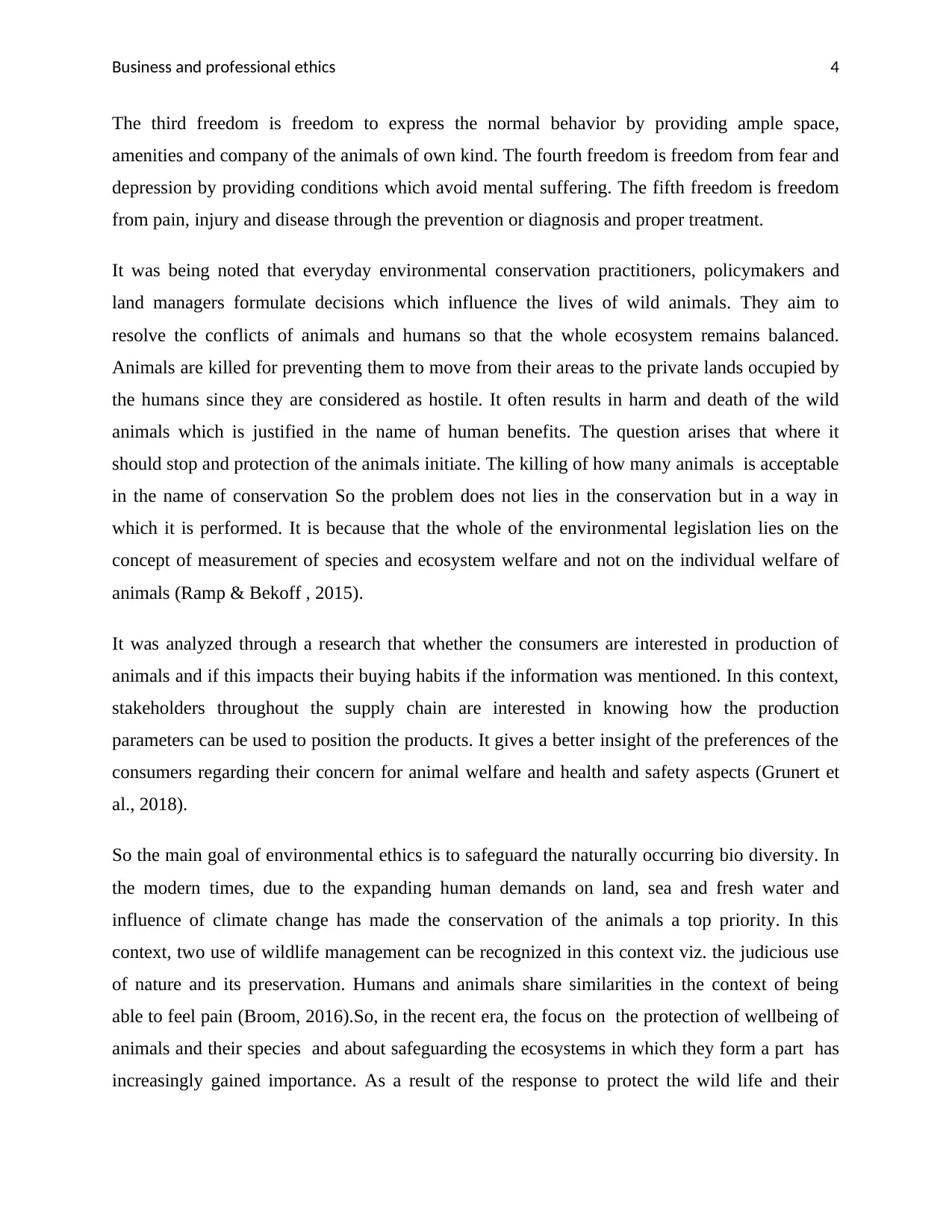
Business and professional ethics 4
The third freedom is freedom to express the normal behavior by providing ample space,
amenities and company of the animals of own kind. The fourth freedom is freedom from fear and
depression by providing conditions which avoid mental suffering. The fifth freedom is freedom
from pain, injury and disease through the prevention or diagnosis and proper treatment.
It was being noted that everyday environmental conservation practitioners, policymakers and
land managers formulate decisions which influence the lives of wild animals. They aim to
resolve the conflicts of animals and humans so that the whole ecosystem remains balanced.
Animals are killed for preventing them to move from their areas to the private lands occupied by
the humans since they are considered as hostile. It often results in harm and death of the wild
animals which is justified in the name of human benefits. The question arises that where it
should stop and protection of the animals initiate. The killing of how many animals is acceptable
in the name of conservation So the problem does not lies in the conservation but in a way in
which it is performed. It is because that the whole of the environmental legislation lies on the
concept of measurement of species and ecosystem welfare and not on the individual welfare of
animals (Ramp & Bekoff , 2015).
It was analyzed through a research that whether the consumers are interested in production of
animals and if this impacts their buying habits if the information was mentioned. In this context,
stakeholders throughout the supply chain are interested in knowing how the production
parameters can be used to position the products. It gives a better insight of the preferences of the
consumers regarding their concern for animal welfare and health and safety aspects (Grunert et
al., 2018).
So the main goal of environmental ethics is to safeguard the naturally occurring bio diversity. In
the modern times, due to the expanding human demands on land, sea and fresh water and
influence of climate change has made the conservation of the animals a top priority. In this
context, two use of wildlife management can be recognized in this context viz. the judicious use
of nature and its preservation. Humans and animals share similarities in the context of being
able to feel pain (Broom, 2016).So, in the recent era, the focus on the protection of wellbeing of
animals and their species and about safeguarding the ecosystems in which they form a part has
increasingly gained importance. As a result of the response to protect the wild life and their
The third freedom is freedom to express the normal behavior by providing ample space,
amenities and company of the animals of own kind. The fourth freedom is freedom from fear and
depression by providing conditions which avoid mental suffering. The fifth freedom is freedom
from pain, injury and disease through the prevention or diagnosis and proper treatment.
It was being noted that everyday environmental conservation practitioners, policymakers and
land managers formulate decisions which influence the lives of wild animals. They aim to
resolve the conflicts of animals and humans so that the whole ecosystem remains balanced.
Animals are killed for preventing them to move from their areas to the private lands occupied by
the humans since they are considered as hostile. It often results in harm and death of the wild
animals which is justified in the name of human benefits. The question arises that where it
should stop and protection of the animals initiate. The killing of how many animals is acceptable
in the name of conservation So the problem does not lies in the conservation but in a way in
which it is performed. It is because that the whole of the environmental legislation lies on the
concept of measurement of species and ecosystem welfare and not on the individual welfare of
animals (Ramp & Bekoff , 2015).
It was analyzed through a research that whether the consumers are interested in production of
animals and if this impacts their buying habits if the information was mentioned. In this context,
stakeholders throughout the supply chain are interested in knowing how the production
parameters can be used to position the products. It gives a better insight of the preferences of the
consumers regarding their concern for animal welfare and health and safety aspects (Grunert et
al., 2018).
So the main goal of environmental ethics is to safeguard the naturally occurring bio diversity. In
the modern times, due to the expanding human demands on land, sea and fresh water and
influence of climate change has made the conservation of the animals a top priority. In this
context, two use of wildlife management can be recognized in this context viz. the judicious use
of nature and its preservation. Humans and animals share similarities in the context of being
able to feel pain (Broom, 2016).So, in the recent era, the focus on the protection of wellbeing of
animals and their species and about safeguarding the ecosystems in which they form a part has
increasingly gained importance. As a result of the response to protect the wild life and their
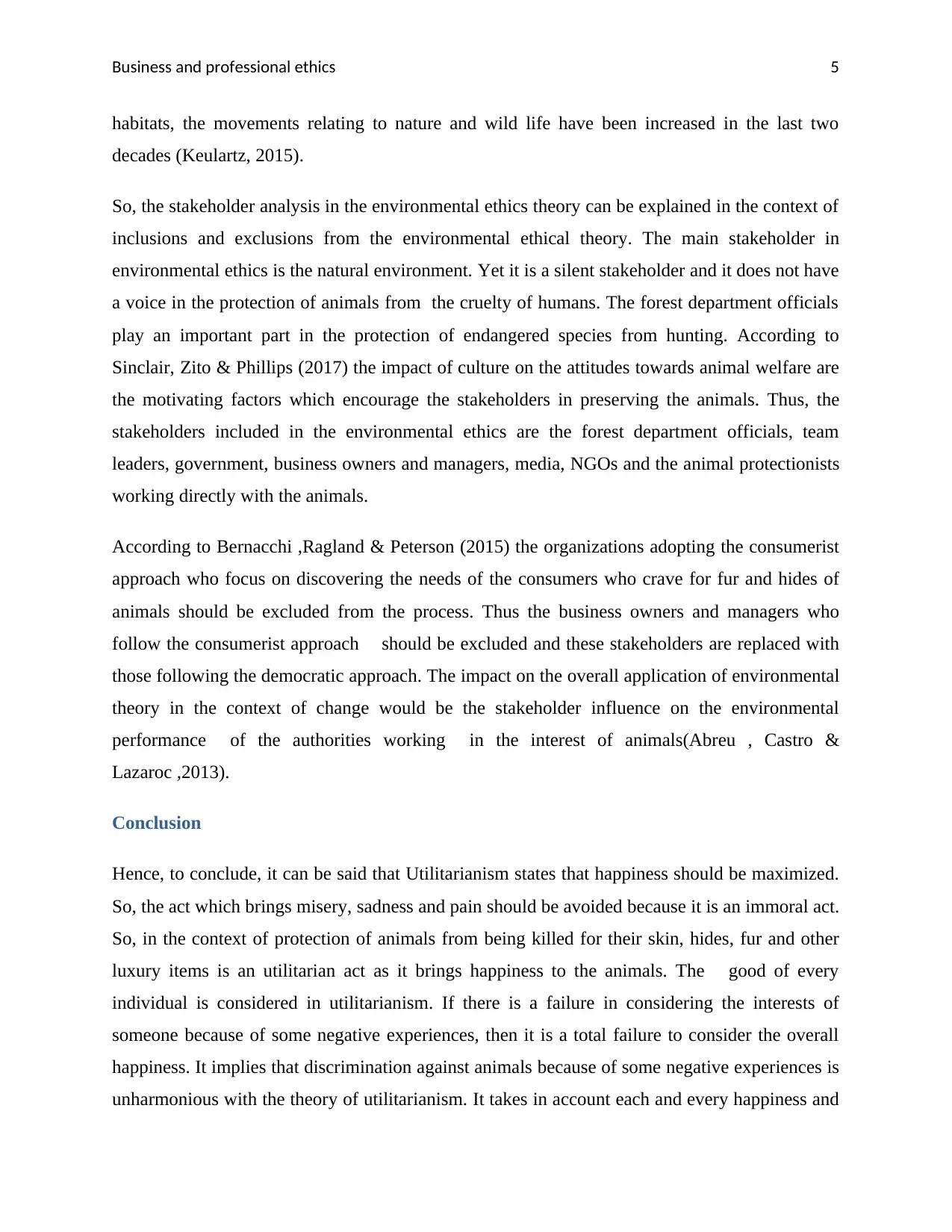
Business and professional ethics 5
habitats, the movements relating to nature and wild life have been increased in the last two
decades (Keulartz, 2015).
So, the stakeholder analysis in the environmental ethics theory can be explained in the context of
inclusions and exclusions from the environmental ethical theory. The main stakeholder in
environmental ethics is the natural environment. Yet it is a silent stakeholder and it does not have
a voice in the protection of animals from the cruelty of humans. The forest department officials
play an important part in the protection of endangered species from hunting. According to
Sinclair, Zito & Phillips (2017) the impact of culture on the attitudes towards animal welfare are
the motivating factors which encourage the stakeholders in preserving the animals. Thus, the
stakeholders included in the environmental ethics are the forest department officials, team
leaders, government, business owners and managers, media, NGOs and the animal protectionists
working directly with the animals.
According to Bernacchi ,Ragland & Peterson (2015) the organizations adopting the consumerist
approach who focus on discovering the needs of the consumers who crave for fur and hides of
animals should be excluded from the process. Thus the business owners and managers who
follow the consumerist approach should be excluded and these stakeholders are replaced with
those following the democratic approach. The impact on the overall application of environmental
theory in the context of change would be the stakeholder influence on the environmental
performance of the authorities working in the interest of animals(Abreu , Castro &
Lazaroc ,2013).
Conclusion
Hence, to conclude, it can be said that Utilitarianism states that happiness should be maximized.
So, the act which brings misery, sadness and pain should be avoided because it is an immoral act.
So, in the context of protection of animals from being killed for their skin, hides, fur and other
luxury items is an utilitarian act as it brings happiness to the animals. The good of every
individual is considered in utilitarianism. If there is a failure in considering the interests of
someone because of some negative experiences, then it is a total failure to consider the overall
happiness. It implies that discrimination against animals because of some negative experiences is
unharmonious with the theory of utilitarianism. It takes in account each and every happiness and
habitats, the movements relating to nature and wild life have been increased in the last two
decades (Keulartz, 2015).
So, the stakeholder analysis in the environmental ethics theory can be explained in the context of
inclusions and exclusions from the environmental ethical theory. The main stakeholder in
environmental ethics is the natural environment. Yet it is a silent stakeholder and it does not have
a voice in the protection of animals from the cruelty of humans. The forest department officials
play an important part in the protection of endangered species from hunting. According to
Sinclair, Zito & Phillips (2017) the impact of culture on the attitudes towards animal welfare are
the motivating factors which encourage the stakeholders in preserving the animals. Thus, the
stakeholders included in the environmental ethics are the forest department officials, team
leaders, government, business owners and managers, media, NGOs and the animal protectionists
working directly with the animals.
According to Bernacchi ,Ragland & Peterson (2015) the organizations adopting the consumerist
approach who focus on discovering the needs of the consumers who crave for fur and hides of
animals should be excluded from the process. Thus the business owners and managers who
follow the consumerist approach should be excluded and these stakeholders are replaced with
those following the democratic approach. The impact on the overall application of environmental
theory in the context of change would be the stakeholder influence on the environmental
performance of the authorities working in the interest of animals(Abreu , Castro &
Lazaroc ,2013).
Conclusion
Hence, to conclude, it can be said that Utilitarianism states that happiness should be maximized.
So, the act which brings misery, sadness and pain should be avoided because it is an immoral act.
So, in the context of protection of animals from being killed for their skin, hides, fur and other
luxury items is an utilitarian act as it brings happiness to the animals. The good of every
individual is considered in utilitarianism. If there is a failure in considering the interests of
someone because of some negative experiences, then it is a total failure to consider the overall
happiness. It implies that discrimination against animals because of some negative experiences is
unharmonious with the theory of utilitarianism. It takes in account each and every happiness and
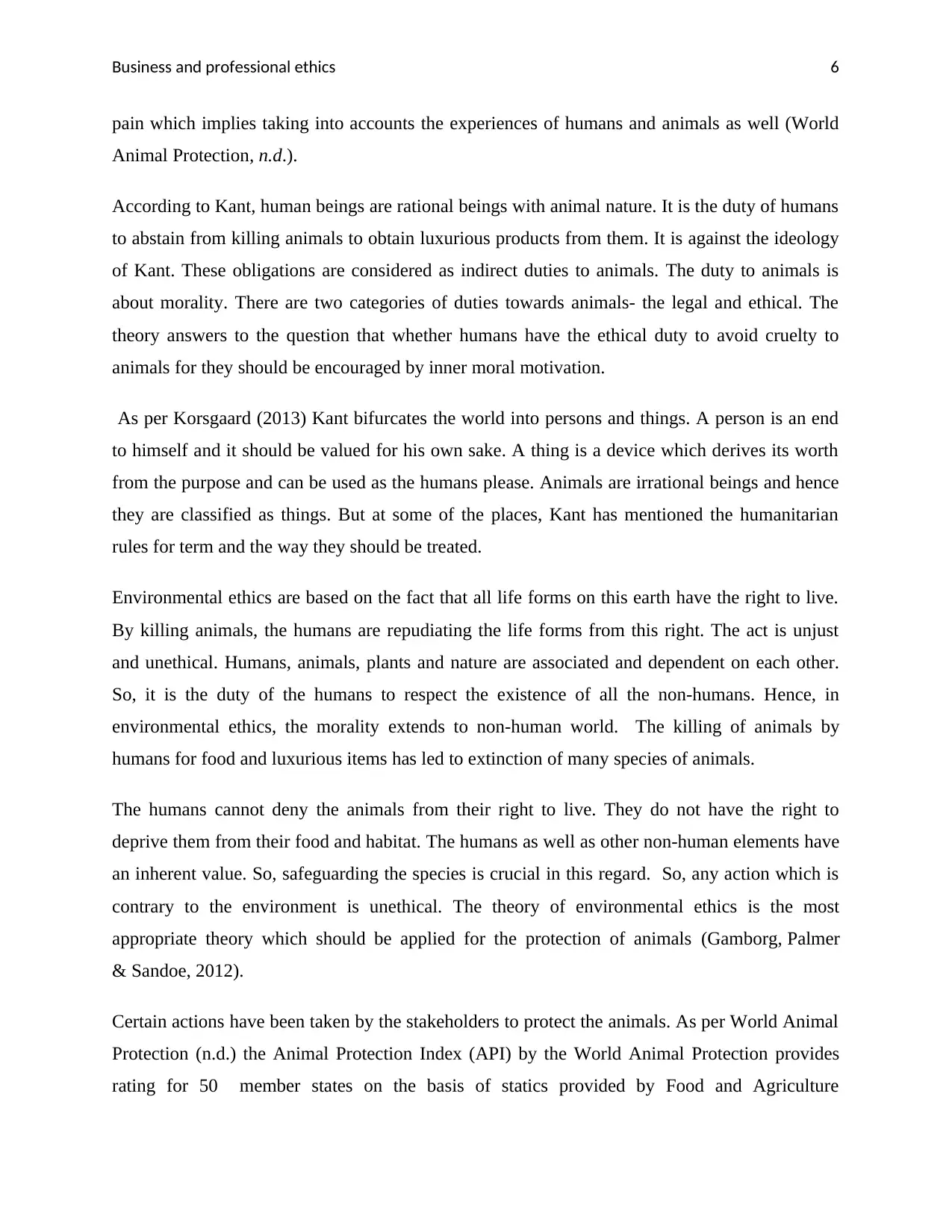
Business and professional ethics 6
pain which implies taking into accounts the experiences of humans and animals as well (World
Animal Protection, n.d.).
According to Kant, human beings are rational beings with animal nature. It is the duty of humans
to abstain from killing animals to obtain luxurious products from them. It is against the ideology
of Kant. These obligations are considered as indirect duties to animals. The duty to animals is
about morality. There are two categories of duties towards animals- the legal and ethical. The
theory answers to the question that whether humans have the ethical duty to avoid cruelty to
animals for they should be encouraged by inner moral motivation.
As per Korsgaard (2013) Kant bifurcates the world into persons and things. A person is an end
to himself and it should be valued for his own sake. A thing is a device which derives its worth
from the purpose and can be used as the humans please. Animals are irrational beings and hence
they are classified as things. But at some of the places, Kant has mentioned the humanitarian
rules for term and the way they should be treated.
Environmental ethics are based on the fact that all life forms on this earth have the right to live.
By killing animals, the humans are repudiating the life forms from this right. The act is unjust
and unethical. Humans, animals, plants and nature are associated and dependent on each other.
So, it is the duty of the humans to respect the existence of all the non-humans. Hence, in
environmental ethics, the morality extends to non-human world. The killing of animals by
humans for food and luxurious items has led to extinction of many species of animals.
The humans cannot deny the animals from their right to live. They do not have the right to
deprive them from their food and habitat. The humans as well as other non-human elements have
an inherent value. So, safeguarding the species is crucial in this regard. So, any action which is
contrary to the environment is unethical. The theory of environmental ethics is the most
appropriate theory which should be applied for the protection of animals (Gamborg, Palmer
& Sandoe, 2012).
Certain actions have been taken by the stakeholders to protect the animals. As per World Animal
Protection (n.d.) the Animal Protection Index (API) by the World Animal Protection provides
rating for 50 member states on the basis of statics provided by Food and Agriculture
pain which implies taking into accounts the experiences of humans and animals as well (World
Animal Protection, n.d.).
According to Kant, human beings are rational beings with animal nature. It is the duty of humans
to abstain from killing animals to obtain luxurious products from them. It is against the ideology
of Kant. These obligations are considered as indirect duties to animals. The duty to animals is
about morality. There are two categories of duties towards animals- the legal and ethical. The
theory answers to the question that whether humans have the ethical duty to avoid cruelty to
animals for they should be encouraged by inner moral motivation.
As per Korsgaard (2013) Kant bifurcates the world into persons and things. A person is an end
to himself and it should be valued for his own sake. A thing is a device which derives its worth
from the purpose and can be used as the humans please. Animals are irrational beings and hence
they are classified as things. But at some of the places, Kant has mentioned the humanitarian
rules for term and the way they should be treated.
Environmental ethics are based on the fact that all life forms on this earth have the right to live.
By killing animals, the humans are repudiating the life forms from this right. The act is unjust
and unethical. Humans, animals, plants and nature are associated and dependent on each other.
So, it is the duty of the humans to respect the existence of all the non-humans. Hence, in
environmental ethics, the morality extends to non-human world. The killing of animals by
humans for food and luxurious items has led to extinction of many species of animals.
The humans cannot deny the animals from their right to live. They do not have the right to
deprive them from their food and habitat. The humans as well as other non-human elements have
an inherent value. So, safeguarding the species is crucial in this regard. So, any action which is
contrary to the environment is unethical. The theory of environmental ethics is the most
appropriate theory which should be applied for the protection of animals (Gamborg, Palmer
& Sandoe, 2012).
Certain actions have been taken by the stakeholders to protect the animals. As per World Animal
Protection (n.d.) the Animal Protection Index (API) by the World Animal Protection provides
rating for 50 member states on the basis of statics provided by Food and Agriculture
Paraphrase This Document
Need a fresh take? Get an instant paraphrase of this document with our AI Paraphraser
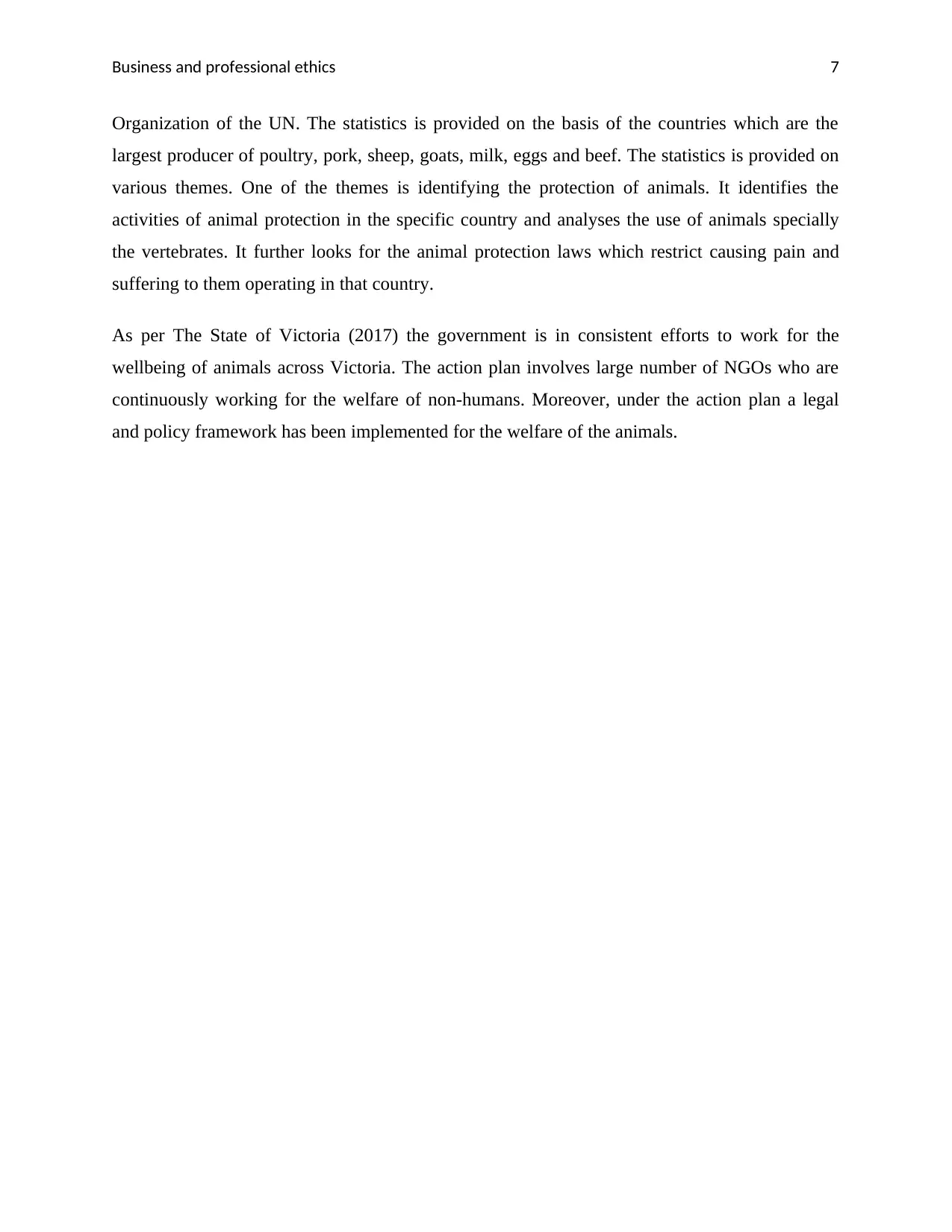
Business and professional ethics 7
Organization of the UN. The statistics is provided on the basis of the countries which are the
largest producer of poultry, pork, sheep, goats, milk, eggs and beef. The statistics is provided on
various themes. One of the themes is identifying the protection of animals. It identifies the
activities of animal protection in the specific country and analyses the use of animals specially
the vertebrates. It further looks for the animal protection laws which restrict causing pain and
suffering to them operating in that country.
As per The State of Victoria (2017) the government is in consistent efforts to work for the
wellbeing of animals across Victoria. The action plan involves large number of NGOs who are
continuously working for the welfare of non-humans. Moreover, under the action plan a legal
and policy framework has been implemented for the welfare of the animals.
Organization of the UN. The statistics is provided on the basis of the countries which are the
largest producer of poultry, pork, sheep, goats, milk, eggs and beef. The statistics is provided on
various themes. One of the themes is identifying the protection of animals. It identifies the
activities of animal protection in the specific country and analyses the use of animals specially
the vertebrates. It further looks for the animal protection laws which restrict causing pain and
suffering to them operating in that country.
As per The State of Victoria (2017) the government is in consistent efforts to work for the
wellbeing of animals across Victoria. The action plan involves large number of NGOs who are
continuously working for the welfare of non-humans. Moreover, under the action plan a legal
and policy framework has been implemented for the welfare of the animals.
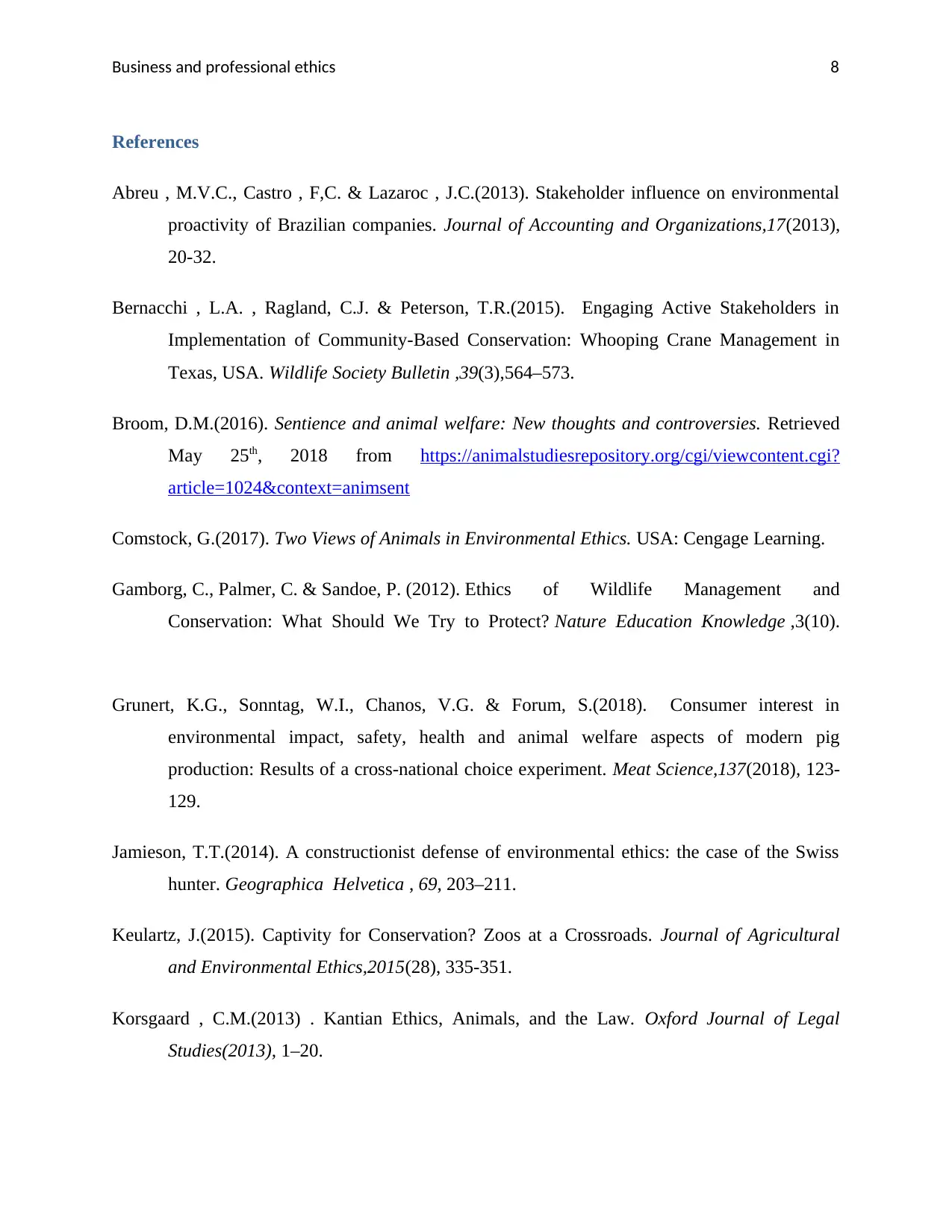
Business and professional ethics 8
References
Abreu , M.V.C., Castro , F,C. & Lazaroc , J.C.(2013). Stakeholder influence on environmental
proactivity of Brazilian companies. Journal of Accounting and Organizations,17(2013),
20-32.
Bernacchi , L.A. , Ragland, C.J. & Peterson, T.R.(2015). Engaging Active Stakeholders in
Implementation of Community-Based Conservation: Whooping Crane Management in
Texas, USA. Wildlife Society Bulletin ,39(3),564–573.
Broom, D.M.(2016). Sentience and animal welfare: New thoughts and controversies. Retrieved
May 25th, 2018 from https://animalstudiesrepository.org/cgi/viewcontent.cgi?
article=1024&context=animsent
Comstock, G.(2017). Two Views of Animals in Environmental Ethics. USA: Cengage Learning.
Gamborg, C., Palmer, C. & Sandoe, P. (2012). Ethics of Wildlife Management and
Conservation: What Should We Try to Protect? Nature Education Knowledge ,3(10).
Grunert, K.G., Sonntag, W.I., Chanos, V.G. & Forum, S.(2018). Consumer interest in
environmental impact, safety, health and animal welfare aspects of modern pig
production: Results of a cross-national choice experiment. Meat Science,137(2018), 123-
129.
Jamieson, T.T.(2014). A constructionist defense of environmental ethics: the case of the Swiss
hunter. Geographica Helvetica , 69, 203–211.
Keulartz, J.(2015). Captivity for Conservation? Zoos at a Crossroads. Journal of Agricultural
and Environmental Ethics,2015(28), 335-351.
Korsgaard , C.M.(2013) . Kantian Ethics, Animals, and the Law. Oxford Journal of Legal
Studies(2013), 1–20.
References
Abreu , M.V.C., Castro , F,C. & Lazaroc , J.C.(2013). Stakeholder influence on environmental
proactivity of Brazilian companies. Journal of Accounting and Organizations,17(2013),
20-32.
Bernacchi , L.A. , Ragland, C.J. & Peterson, T.R.(2015). Engaging Active Stakeholders in
Implementation of Community-Based Conservation: Whooping Crane Management in
Texas, USA. Wildlife Society Bulletin ,39(3),564–573.
Broom, D.M.(2016). Sentience and animal welfare: New thoughts and controversies. Retrieved
May 25th, 2018 from https://animalstudiesrepository.org/cgi/viewcontent.cgi?
article=1024&context=animsent
Comstock, G.(2017). Two Views of Animals in Environmental Ethics. USA: Cengage Learning.
Gamborg, C., Palmer, C. & Sandoe, P. (2012). Ethics of Wildlife Management and
Conservation: What Should We Try to Protect? Nature Education Knowledge ,3(10).
Grunert, K.G., Sonntag, W.I., Chanos, V.G. & Forum, S.(2018). Consumer interest in
environmental impact, safety, health and animal welfare aspects of modern pig
production: Results of a cross-national choice experiment. Meat Science,137(2018), 123-
129.
Jamieson, T.T.(2014). A constructionist defense of environmental ethics: the case of the Swiss
hunter. Geographica Helvetica , 69, 203–211.
Keulartz, J.(2015). Captivity for Conservation? Zoos at a Crossroads. Journal of Agricultural
and Environmental Ethics,2015(28), 335-351.
Korsgaard , C.M.(2013) . Kantian Ethics, Animals, and the Law. Oxford Journal of Legal
Studies(2013), 1–20.
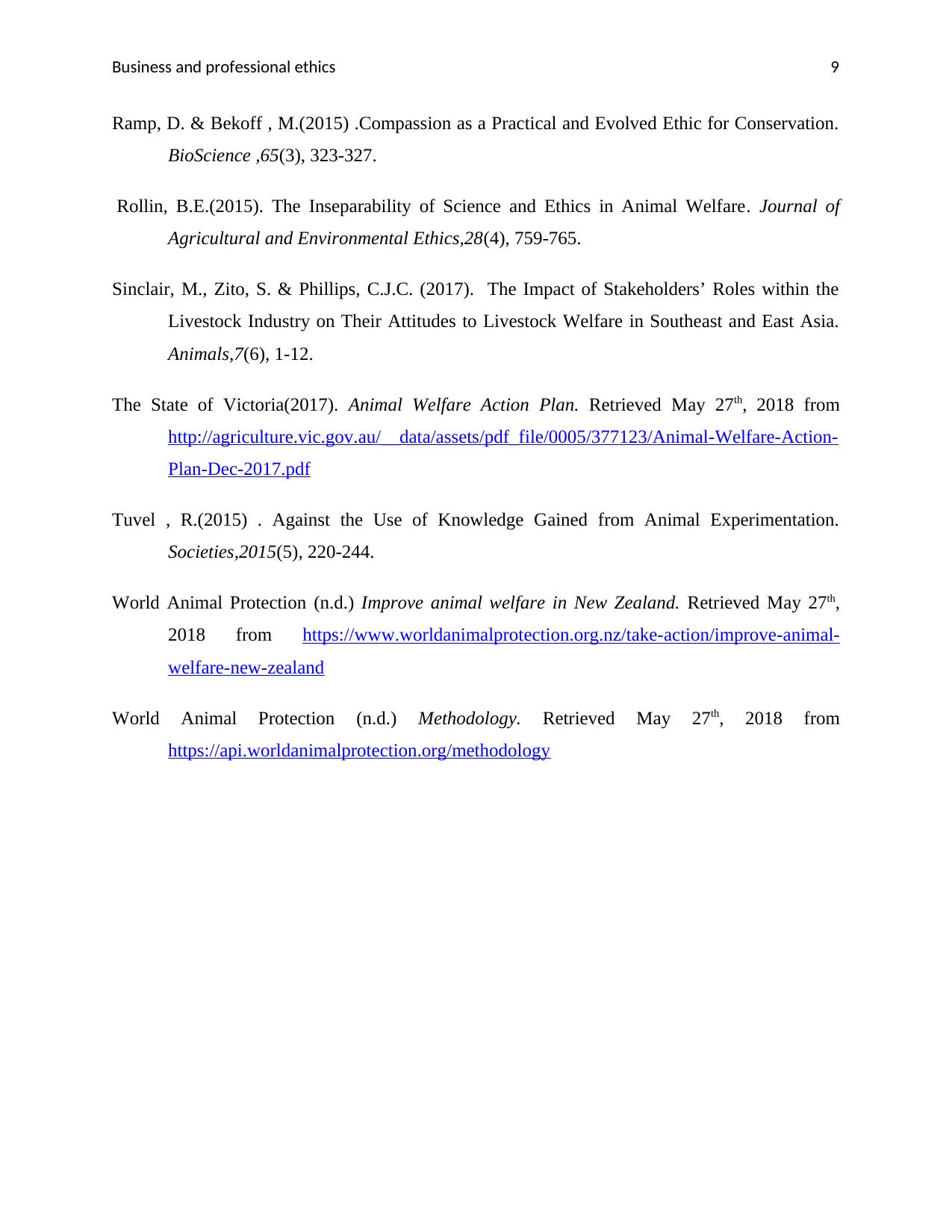
Business and professional ethics 9
Ramp, D. & Bekoff , M.(2015) .Compassion as a Practical and Evolved Ethic for Conservation.
BioScience ,65(3), 323-327.
Rollin, B.E.(2015). The Inseparability of Science and Ethics in Animal Welfare. Journal of
Agricultural and Environmental Ethics,28(4), 759-765.
Sinclair, M., Zito, S. & Phillips, C.J.C. (2017). The Impact of Stakeholders’ Roles within the
Livestock Industry on Their Attitudes to Livestock Welfare in Southeast and East Asia.
Animals,7(6), 1-12.
The State of Victoria(2017). Animal Welfare Action Plan. Retrieved May 27th, 2018 from
http://agriculture.vic.gov.au/__data/assets/pdf_file/0005/377123/Animal-Welfare-Action-
Plan-Dec-2017.pdf
Tuvel , R.(2015) . Against the Use of Knowledge Gained from Animal Experimentation.
Societies,2015(5), 220-244.
World Animal Protection (n.d.) Improve animal welfare in New Zealand. Retrieved May 27th,
2018 from https://www.worldanimalprotection.org.nz/take-action/improve-animal-
welfare-new-zealand
World Animal Protection (n.d.) Methodology. Retrieved May 27th, 2018 from
https://api.worldanimalprotection.org/methodology
Ramp, D. & Bekoff , M.(2015) .Compassion as a Practical and Evolved Ethic for Conservation.
BioScience ,65(3), 323-327.
Rollin, B.E.(2015). The Inseparability of Science and Ethics in Animal Welfare. Journal of
Agricultural and Environmental Ethics,28(4), 759-765.
Sinclair, M., Zito, S. & Phillips, C.J.C. (2017). The Impact of Stakeholders’ Roles within the
Livestock Industry on Their Attitudes to Livestock Welfare in Southeast and East Asia.
Animals,7(6), 1-12.
The State of Victoria(2017). Animal Welfare Action Plan. Retrieved May 27th, 2018 from
http://agriculture.vic.gov.au/__data/assets/pdf_file/0005/377123/Animal-Welfare-Action-
Plan-Dec-2017.pdf
Tuvel , R.(2015) . Against the Use of Knowledge Gained from Animal Experimentation.
Societies,2015(5), 220-244.
World Animal Protection (n.d.) Improve animal welfare in New Zealand. Retrieved May 27th,
2018 from https://www.worldanimalprotection.org.nz/take-action/improve-animal-
welfare-new-zealand
World Animal Protection (n.d.) Methodology. Retrieved May 27th, 2018 from
https://api.worldanimalprotection.org/methodology
1 out of 10
Related Documents
Your All-in-One AI-Powered Toolkit for Academic Success.
+13062052269
info@desklib.com
Available 24*7 on WhatsApp / Email
![[object Object]](/_next/static/media/star-bottom.7253800d.svg)
Unlock your academic potential
© 2024 | Zucol Services PVT LTD | All rights reserved.
